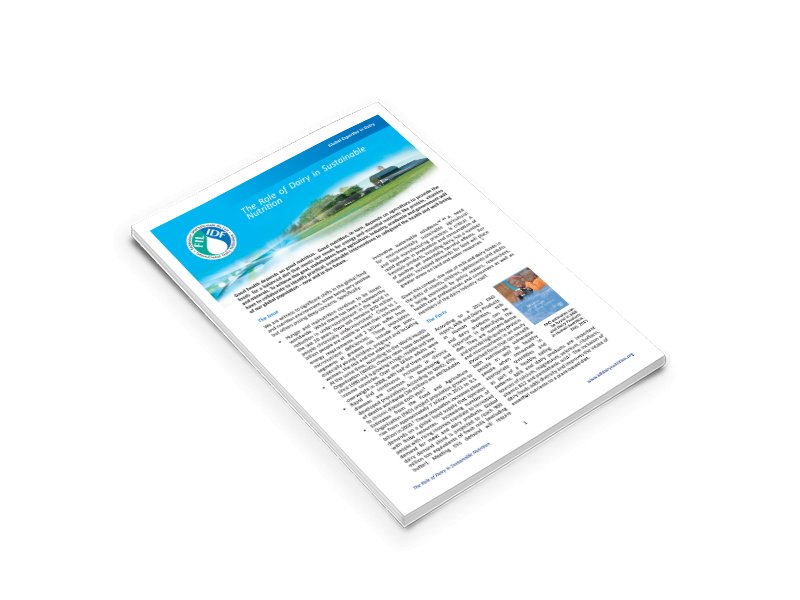The global dairy sector works every day to nourish the world population with safe and nutritious foods and strives to do so in a sustainable manner. Over 6 billion people around the world rely on dairy for nutrition daily. Dairy products are nutrient-dense foods, supplying significant amounts of energy, high-quality protein, and micronutrients, including calcium, magnesium, selenium, riboflavin, and vitamins B5 and B12.
Dairying is also essential to provide livelihoods to one billion people and to feed many more, some of them living in chronic poverty, hunger and undernutrition. Producing, trading and consuming milk and dairy products is essential to building strong communities around the world. The dairy sector helps to create resilient food systems where everyone has enough good-quality food to lead healthy, productive lives and, at the same time, to ensure a thriving planet for future generations.
In this context, the global dairy sector is committed to reducing its impact on GHG emissions, water and land use, while optimizing its positive contribution on soil and eco-system services. This commitment is expressed in the creation of the Dairy Sustainability Framework in 2013, the Dairy Declaration of Rotterdam, signed in 2016 between the IDF and the FAO, and the launch of the Pathways to Dairy Net Zero climate initiative in 2021. At the same time, several companies, including the top 8 largest dairy companies globally, have set science based targets to stay within the Paris agreements 1,5/2 degrees boundary[1]
The agricultural sector differs compared to other sectors, as most sectors, like energy and transport, mainly emit fossil CO2, while the emissions from the agricultural/dairy sector mainly consists of N2O and methane, which originates from natural biological processes. Hence, fossil CO2 is the real challenge, but focus needs to be on reducing all GHG emissions. Methane emissions (standing for about 16% of global GHG emissions) are an increasing cause of concern as the COP27 Ministerial Meeting on methane shows. The Global Dairy sector acknowledges this. Today, the methane debate to large extent focuses on the cows, but that is only a part of the whole story. Around 60% of global methane emissions comes from anthropogenic sources, and of these roughly 35% comes from fossil fuels, 32% from livestock, 20% from waste and 8% from rice cultivation[2].
Carbon footprinting and mitigation
In order to properly measure and mitigate GHG emissions from dairy, it is important to look at all GHG’s, from cradle to grave. Life cycle stages in dairy production systems are interconnected. This means that decreasing emissions in one life cycle stage in the production system can increase GHG’s elsewhere. Life Cycle Assessment (LCA) -and especially carbon footprinting- is a widely recognized method to do exactly this.
To date there have been over 4,800 peer-reviewed studies investigating and evaluating the carbon footprint from dairy. All this work has resulted in a detailed landscape of how GHGs in dairy are mapped, how they differ between geographies and animal production systems, what their environmental hotspots are, and how these can be mitigated.
These studies demonstrate that carbon footprint decreases with increasing farm productivity. Healthy, long living cows, efficient feed conversion rates, precision fertilization and maximized yields all help to achieve lower carbon footprints on farms.
Methane stands for the largest share of the carbon footprint of dairy products. However, enteric methane emissions can be reduced through the optimization of the cows feed ration, the use of feed additives and breeding strategies. Methane emissions from manure can be reduced by digestion, which yields biogas, an alternative to natural gas. Many dairy farms have started generating solar and wind energy on their farms, which helps the energy transition in general to more renewable energy.
However, comparison between carbon footprint tools, studies and models is difficult due to methodological differences in, for example, system boundaries, allocation methodology or emission factors. Since the invention of LCA, there has been discussion about the different possibilities to calculate carbon footprints. Three important dairy specific standards have been developed over the last few years:
- The IDF global standard for carbon footprinting in the dairy sector, which was updated for the second time in September this year. This standard serves to achieve global alignment and to help dairy carbon footprint specialists across the globe to execute LCA in a consistent manner. It has been developed by a group of over 50 experts from 17 different countries.
- The Product Environmental Footprint Category Rules for dairy were developed as part of a European Union initiative to set rules for environmental footprint and serves as a basis for upcoming legislation in the EU on making Green commercial Claims.
- The FAO’s LEAP guidelines on environmental impact, carbon sequestration and feed additives are guidelines that contain guidance for experts on how to calculate livestock environmental impact and mitigation potential.
All three initiatives are great examples of how the dairy sector comes together to collaborate on measuring and reducing GHG emissions from livestock in a responsible and accountable way.
Dairy climate action
Many dairy companies have set targets to reduce their scope 1, 2 and 3 GHG emissions. To follow up on their targets, companies collect data and calculate their carbon footprint both on farm level as well as the rest of the value chain and many dairy companies have implemented annual carbon footprint monitoring on farms. Some companies also have financial models to incentivize farmers to reduce GHG emissions. To pilot new GHG mitigation options, dairy companies collaborate both with each other and with partners up and downstream in the value chain.
Many technologies for mitigation options are ready for implementation. However, implementation on dairy farms requires external financial support of farmers as investment costs are substantial. Practical implementation and scaling up any mitigation technology also requires time, and investors and governments among other actors should act now to support the dairy industry to make this transition.
Carbon removals
One of the things that has typically been missing in carbon footprint, is the potential carbon sequestration, which can have a significant impact on the carbon footprint for some products. Carbon sequestration is defined as CO₂ that has been removed from the atmosphere and stored in organic stocks like soil, trees and other vegetation. Grasslands are high in soil organic carbon and permanent grasslands have deep roots. This makes them climate resilient, but also removes CO2 from the atmosphere, because grassland soils (especially permanent ones) have higher carbon stocks -or carbon concentration- than arable soils. Grasslands are therefore more resilient to drought and flooding, as a result of climate change, particularly if they could be combined with agroforestry in the future. However, maintaining these stocks is essential for achieving a climate resilient agricultural system.
Carbon sequestration is not as simple as having some pasture or trees, as additional “management actions” are required. Carbon sequestration occurs when the uptake of CO2 (photosynthesis) is greater than emissions (respiration). Carbon sequestration plays an important role in mitigating climate change and for the industry to reach ‘net zero’.
As the Global Dairy commitment to climate action grows, there is an increasing need for standard guidance on how to account for gains and losses of sequestered carbon in dairy and beef (or other agricultural) LCA, carbon footprinting, and GHG accounting. Without the right guidance, there can be inconsistencies across assessments and approaches for carbon sequestration. To include carbon sequestration it is important to ensure that the advice provided to farmers includes the ‘full picture’ and promotes effective carbon sequestration as an actual mitigation action against climate change (along with emission reductions).
Different dairy actors have recently engaged in establishing a carbon sequestration calculation method to be used in carbon footprint assessments at the farm level. The ultimate goal is to develop an approach that quantifies carbon sequestration in terms of climate change mitigation, that will support and encourage farmers to implement activities and practices that promote carbon removal. This resulted in the C-Sequ guidelines for calculating carbon sequestration in cattle production systems.
Methane
Methane is a more potent (‘stronger’) greenhouse gas compared to CO2 but has a shorter lifetime in the atmosphere (about twelve years). This means that methane only stays in the atmosphere on average about twelve years.
The methane produced by dairy as a result of enteric fermentation and manure comes from biogenic sources. This means that the feed that the cow eats has sequestrated CO2 from the atmosphere when it grows. Thus, the methane from the cow and the manure are within the ‘short’ (biogenic) carbon cycle, as opposed to the ‘long’ (fossil) carbon cycle, as is the case of combustion of fossil fuels. Hence, the global warming potential for biogenic methane is slightly lower than for fossil methane (27 compared to 29,8).
Since methane is a short lived GHG, the change in emission rate affects how methane impacts the temperature. There has been major progress in the method development to assess the actual impact of methane on temperature change, which resulted in the Global Warming Potential* (GWP*).
The research behind this new methodology has demonstrated that the true climate impact of methane is not currently being reflected (in the e.g. GWP100, which typically is used in GHG accounting) because current metrics don’t recognize that methane breaks down in the atmosphere over the course of 12 years. Other greenhouse gases (GHGs), such as CO2 released from the burning of fossil fuels, will remain in the atmosphere for hundreds of years, unless they are artificially removed and stored.
In conclusion
As mentioned, the dairy sector is committed to reduce its emissions and increasing its removals, and Pathways to Dairy Net Zero is an example of that. There are ongoing actions and technologies already available to reduce GHG emissions, however, financing to implement these, as well as further investment in research and innovation, are still necessary. Also, knowledge sharing and collaboration is critical for the dairy sector to achieve its goals.
Moreover, to have robust methods in place, to quantify and follow up on GHG emissions and reductions over time, is also required, as well as helping to prioritize actions to gain most efficiency. The dairy sector has worked with method development for a long time, and it is following the scientific development to continually improve methodologies, such as LCA and carbon footprinting, carbon sequestration and GWP*.
The Dairy sector as well as other industries, governments and the global community in general must commit to specific and accountable actions to achieve the goals that the UN Framework Convention on Climate Change have set. There is no time for further delays or distractions. As the COP27 theme states: we need to engage together for implementation. We need climate action now. IDF programme of work is deeply focused on spreading knowledge for this purpose.
[1] https://sciencebasedtargets.org/companies-taking-action#table
[2] Global Methane Assessment (full report) | Climate & Clean Air Coalition (ccacoalition.org)















